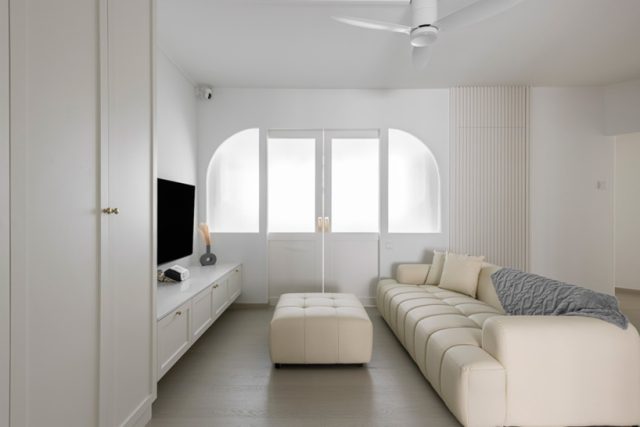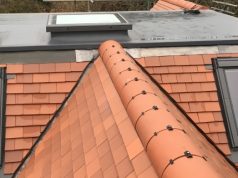When embarking on 4 room hdb bto living room design, new homeowners confront a space that measures approximately 20 to 24 square metres, a canvas that seems simultaneously generous and constraining. This is the heart of the flat, the room where families gather, where guests form their first impressions, and where daily life unfolds in all its mundane complexity. The living room in a four-room Build-To-Order flat represents a peculiar challenge: how to create a space that accommodates multiple functions without sacrificing coherence or comfort.
Understanding Your Spatial Reality
The typical four-room BTO living room connects to a dining area, forming an open-plan layout that has become standard in contemporary HDB design. This configuration offers flexibility but demands careful planning. Without physical walls to define zones, the designer must employ other strategies to create distinct areas for lounging, entertainment, and circulation.
The Housing and Development Board’s layout typically positions the living room with access to a balcony, providing natural light and ventilation. This becomes a significant asset in the tropical climate, though it also introduces considerations about heat gain and privacy. The dimensions allow for substantial furniture whilst maintaining traffic flow, a luxury absent in smaller flat types.
Zoning Without Walls
Creating distinct zones within your open-plan living room requires subtle demarcation:
• Area rugs that define seating zones without obstructing movement
• Low-profile furniture like console tables that separate spaces visually
• Lighting schemes that distinguish between lounging and dining areas
• Strategic furniture placement that guides circulation patterns
• Colour variations or accent walls that define specific zones
The skill lies in achieving separation without fragmentation. A well-executed 4 room hdb bto living room design maintains visual continuity whilst allowing each zone to serve its purpose. The sofa might face the television wall, positioned to create a natural boundary between living and dining areas, whilst a console table behind it provides storage and a surface for display.
Furniture Selection and Scale
Scale matters profoundly in a space of this size. Oversized sectional sofas might seem appealing in showrooms but can overwhelm a 20-square-metre room. The objective involves selecting pieces that provide adequate seating without dominating the space. A three-seater sofa paired with an accent chair often proves more versatile than an L-shaped sectional.
Consider furniture with exposed legs rather than pieces that sit directly on the floor. This simple choice creates visual lightness and makes the room feel more spacious. Similarly, glass or acrylic coffee tables maintain functionality whilst allowing sight lines to pass through uninterrupted.
Storage presents an ongoing challenge in HDB living. Built-in cabinets along one wall, television consoles with concealed storage, and multi-functional furniture pieces help contain the accumulation of belongings that threatens to overtake any family home.
Natural Light and Artificial Illumination
The balcony access in most four-room BTO floods the living room with natural light, a resource that shapes the entire design approach. Window treatments must balance privacy with light admission. Sheer curtains layered with blackout options provide flexibility, allowing residents to control both illumination and heat gain throughout the day.
Artificial lighting requires a layered approach:
• Ceiling-mounted ambient lighting that illuminates the entire space
• Task lighting for reading or specific activities
• Accent lighting that highlights architectural features or artwork
• Dimmable options that adjust to different times of day and occasions
The ubiquitous downlights found in HDB flats provide basic illumination but rarely suffice alone. Floor lamps, table lamps, and wall sconces add depth and create atmosphere that overhead lighting cannot achieve.
Colour Palettes and Visual Coherence
White remains the default wall colour in Singapore’s HDB flats, a practical choice that maximises light reflection and provides a neutral backdrop. Yet the 4-room BTO living room design benefits from thoughtful colour introduction. Accent walls in deeper tones create focal points, whilst maintaining lighter shades on remaining walls preserves the sense of space.
The colour scheme should extend beyond walls to encompass upholstery, curtains, and accessories. A cohesive palette that repeats two or three main colours throughout the space creates visual harmony. This need not mean monotony; texture and pattern variation within a consistent colour range provides interest without chaos.
Balancing Aesthetics and Function
The living room serves multiple masters: it accommodates television viewing, social gatherings, children’s play, and quiet reading. Reconciling these competing demands requires pragmatism. Durable, stain-resistant fabrics suit families with young children. Modular furniture adapts to different configurations as needs evolve.
Technology integration presents its own design challenges. Cable management, equipment storage, and screen placement all require advance planning. The days of hiding everything behind cabinet doors have given way to more integrated approaches, where entertainment systems blend into the overall design rather than dominating it.
The Long View
Trends in living room design shift with predictable regularity. Scandinavian minimalism gives way to maximalist eclecticism, which in turn yields to industrial chic. Yet certain principles transcend fashion: proportion, balance, and functionality remain constant. The most successful spaces reflect their inhabitants’ needs and preferences rather than slavishly following design magazines.
The investment in thoughtful 4 room hdb bto living room design creates not merely an attractive space but a functional foundation for daily life in your new home.






